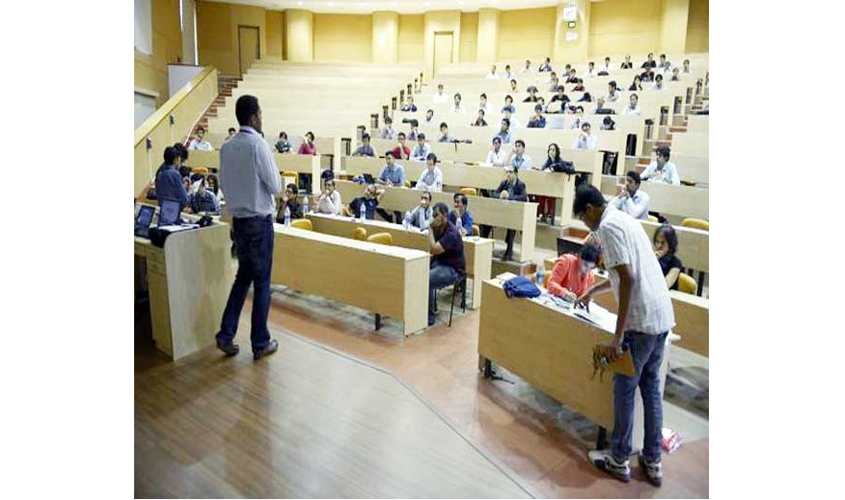Lack of good research projects is one of the key reasons why Indian universities lag behind in international rankings. Other factors affecting their global rankings are the lack of adequate number of research institutes and faculty, and inadequate funding, according to experts. Despite the government increasing grants for research-related activities, industry experts cite the slow bureaucratic process and lack of transparency as among the major challenges that the higher education industry continues to faces.
RESEARCH FUNDING
According to the Ministry of Science and Technology, the total percentage of Gross Domestic Product (GDP), which has been allotted and released to the field of research in science, was 0.88% in 2011, 0.90% in 2012, 0.85% in 2013 and 0.90% in 2014. According to the latest data provided by the Ministry of Human Resource Development (MHRD), during the past three years, the government has allocated Rs 774.88 crore to the Indian Council of Social Science Research, Indian Council of Historical Research, Indian Council of Philosophical Research, Indian Institute of Advanced Study, Shimla, and National Council of Rural Institutes, Hyderabad, for social science research. In addition, funding from grants and their own sources have been provided for social science research by institutions such as Central universities, state universities and Central higher educational institutions like IITs, NITs, IIMs etc. According to the MHRD, during the same period, Rs 9,882.50 crore was allocated to the Department of Science & Technology for implementation of various science and technology related programmes. The funds allocated exclusively for young scientist research programmes during 2013-14, 2014-15, 2015-16 and the current year by the Ministry of Science and Technology are Rs 726.6 crore, Rs 803.2 crore, Rs 987.9 crore and Rs 1,135.1 crore respectively.
LACK OF INSTITUTES, FACULTY
According to a report on “Social Science Research in India” published by the Indian Council of Social Science Research in November last year, there were about 740 universities in the country as of March 2015. Of this, 486 universities have 2,042 social science departments, but the number of teachers per social science department is as low as seven. The average number of teachers per department was even lower in state universities, compared to Central universities and private universities. The number is about six in state universities, seven in Central universities, and 11 in private universities.
According to the report, there are 311 research institutes covering three types, namely, autonomous, government, and research and advocacy groups. Among the three, autonomous institutes number 159 only, while the government institutes mainly engage in training, with research as a supplementary activity. The advocacy and research groups are also primarily engaged in advocacy. Research is undertaken to support their main advocacy activities. The report noted that for a country as vast as India, 159 autonomous institutes are a small number.
Moreover, the findings at the aggregate level indicate that scholarly citation is concentrated at the bottom, with 61% of all articles with no citations and 85% with less than one average citation per year. Readership, as measured by Google hits, is much less concentrated, with only 12% with no hits and 38% with less than one hit per year. It emerged that India’s social science research contributes more to public debates and policy formulations and relatively less in pushing the frontiers of knowledge for further research.
HOW RESEARCH AFFECTS RANKINGS
Clarivate Analytics, formerly the intellectual property and science business of Thomson Reuters, had recently helped the MHRD release the National Institutional Ranking Framework (NIRF) report. Speaking to The Sunday Guardian, Arvind Pachhapur, South Asia Business Head, Clarivate Analytics, said, “The core parameters for NIRF, or any other ranking framework, are the same in terms of overall weightage given to infrastructure, faculty, research, etc. Research corresponds for around 20-25% of the total weightage in the ranking framework, which is why it is an important criterion from all educators’ perspective. We have seen several cases where the overall ranking of an institute was affected because of poor research activities.”
Research activities of an institute affect its rank because research acts as an indicator of the overall academic eco-system. It helps to determine the expansion and commercial opportunities that can facilitate prospects of monetisation through the output of the research done.
Taking cognizance of poor international rankings of Indian universities, Pachhapur said, “Only the IITs and IIMs are able to compete at the international level. But this does not necessarily mean that all our institutes are below par. Collaboration with foreign institutes, bringing in foreign faculty etc., are seen as elite factors while ranking institutes abroad. However, India does not necessarily bring human resource overseas when we have sufficient and good human resource back home. But yes, the focus on research varies
Explaining their university’s research framework, Dr P. Venkat Rangan, Vice Chancellor, Amrita University, Coimbatore, which was number one in NIRF rankings, told The Sunday Guardian, “Over the years, we have attracted grants from various government and private funding agencies to the tune of over Rs 250 crore for our research projects. These have resulted in over 10,000 papers published in reputed international and Indian journals. We have also filed over 100 patents for our inventions. Such high-quality research output has contributed directly to Amrita University emerging as the number one private university in the 2017 NIRF rankings.”
Major research centres of excellence that have been established at Amrita University are in the field of cutting-edge areas of science such as nano-sciences, molecular medicine, biotechnology, wireless sensor networks, computational engineering and networking, robotics and cyber security.
Highlighting the challenges, Dr Rangan said, “Creating an ecosystem for research is vital. The biggest challenges are the lack of transparency and significant delays in decision making processes at the granting agencies. Another issue is discriminatory over-regulation by statutory and granting agencies, with respect to deemed universities. The government needs to provide adequate freedom and funding to deemed universities to empower them to evolve into world-class centres of higher education and research.”

